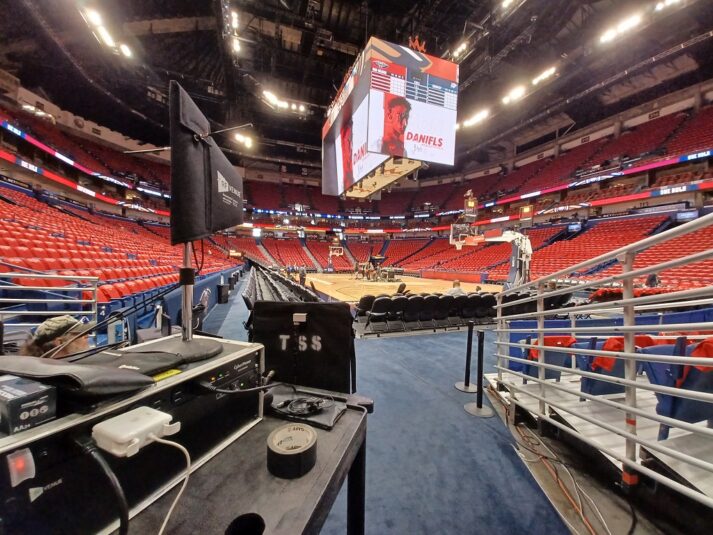New Orleans Saints, Pelicans Make Music Center Stage — Wirelessly
Instruments, mics, power are part of wireless infrastructure devised by The Sound Source
Story Highlights
Imagine doing the scaled-down equivalent of a Super Bowl Halftime Show and doing it as six or more times a game. That’s what The Sound Source owner Tim Kilbride had to figure out several years ago when entertainment coordinators for the New Orleans NBA Pelicans and NFL Saints approached him about filling game breaks with live music at the teams’ respective Smoothie King Center and Superdome venues.
Kilbride, who had built a thriving business providing AV systems for corporate and local sports clients, including the Battle of the Bands at the annual post-Thanksgiving Grambling State Tigers vs. Southern University Jaguars Bayou Classic at Tulane Stadium, was asked to make performances during period/quarter, commercial, and halftime breaks as efficient as possible while getting full impact through the venue PA systems. Microphone cables and other wiring would complicate already heavily trafficked areas of the venues.

A totally wireless infrastructure from The Sound Source supports in-game entertainment at Smoothie King Center.
“My suggestion was to go fully wireless — everything, including power,” says Kilbride, who had toured as a monitor engineer with such artists as Luther Vandross, Tracey Lawrence, and Charlie Daniels. “There needed to be multiple performances during a game, cued up on a carpet that encircled the court, and all the bands had to get into the PA system and have monitors. But the real challenge was that they had to get set up and ready to go for every performance in 90 seconds! Literally, 90 seconds. That’s all they gave us, every game.”
What Kilbride did was construct a completely wireless infrastructure for the music performances. Every instrument and vocal microphone was taken wirelessly, including using XLR and quarter-inch adapters to allow transmitters to connect to DI boxes and line-level instruments, such as synthesizers. Individual drums had a clip-on microphone connected to a transmitter. All monitoring was done using in-ears (IEM) instead of wedges.
All wireless microphones use Shure ULXD, UR4D, and SLXD transmitters, and IEMs are Sennheiser EW300 series, connecting ethereally to RF Venue D-Fin and CP Beam antenna, Distro4 antenna-distribution systems, and a COMBINE4 active IEM transmitter combiner. Implementation of several Jackery Portable Power Stations, rechargeable battery-powered generators, made the live-music production completely wireless, eliminating even the cable for AC power.
“We use the network switch/router so we can network all of our racks of receivers for Shure Wireless Workbench and the Shure Channels app,” Kilbride explains, noting the challenges of adding wireless nodes in an already dense RF environment in a major urban area. “The Superdome in particular is a difficult venue for wireless; even the NFL has issues there. And we do have to do considerable frequency coordination with the teams in each venue.”
Precise Choreography
The logistics also resemble the Super Bowl Halftime Show’s frenetic choreography for moving physical components into place on a schedule measured in seconds. Instead of hundreds of local volunteers doing that for the iconic annual event, the teams’ dozens of cheerleaders are recruited and rehearse exactly which element — kick drum, cymbal stand — to grab and the exact spot to place it adjacent to the field or court for the one- or-two-song interstitial numbers or push a pre-loaded (and still completely wireless) cart to the center of the court or gridiron for longer halftime performances. No matter the type of performance, everyone has only 90 seconds to get everything where it needs to be for the downbeat, without interfering with the flow of the games themselves.

Ivan Neville & Dumpstaphunk rehearse for their halftime performance at a game at New Orleans’ Superdome.
Increasingly ubiquitous and complex, in-game live entertainment is being deployed for regular-season games and at all levels, with some teams building permanent performance stages for their venue. That’s particularly the case for teams in cities notable for their musical heritage.
Nashville’s AAA Sounds’ promote live music under a guitar-shaped scoreboard at First Horizon Park (the restaurant is called the Band Box), and the NHL Predators’ Bridgestone Arena has a performance area built into seating at one end of the rink. The Tennessee Titans’ proposed new stadium will have a permanent concert stage at each end of the venue.
In Memphis, the NBA Grizzlies have a regular house band and MCs at the FedEx Forum, where fans can see performances by local artists, such as the Stax Music Academy’s Street Corner Harmonies and the Memphis Symphony Orchestra.
Kilbride, who provided wireless and other audio support for television productions such as HBO’s 2010-13 Treme, says New Orleans leverages its musical legacy with sports. And there are plenty of choices.
“In New Orleans, we have 50 brass bands, so we’re never using the same ones twice. And we don’t have to go out of town for talent,” he says, noting performances by local legends Ivan Neville & Dumpstaphunk at the Superdome and Rob Base & DJ EZ Rock at Smoothie King Center. “The Saints and the Pelicans are very involved in putting back into the local community. It’d be hard to imagine anything in New Orleans without music.”
